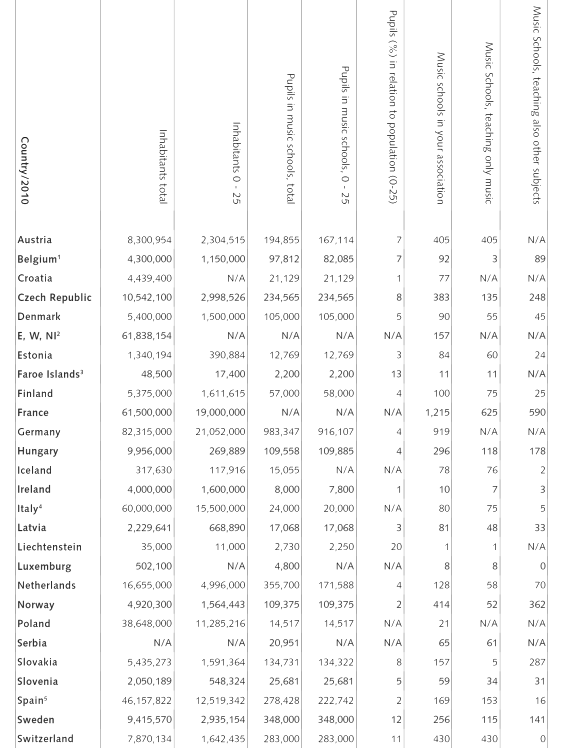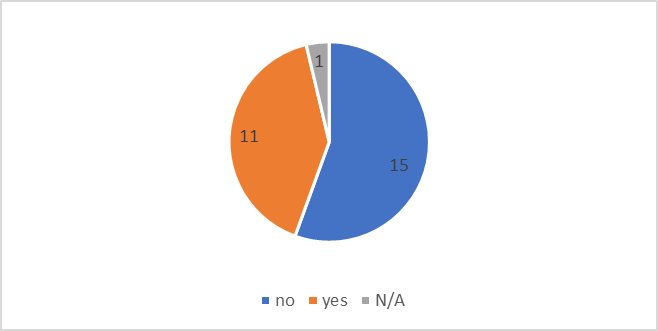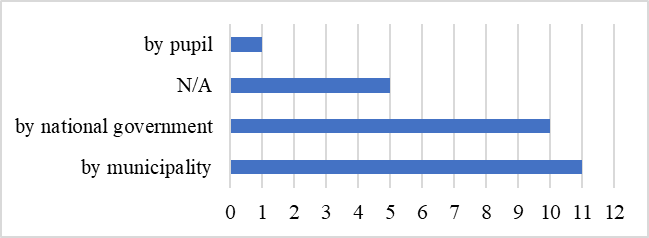Abstract
A System of Czech BAS contains elements of formal education (
Keywords: BASBasic Artistic SchoolEMUmusic educationarts educationformal education
Introduction
Arts education in the 21st century
Nowadays, we are experiencing a rapid development of digital communication and other technologies. It is obvious that progressive automation and robotization of work in the next decades will significantly reduce the number of routine jobs and increase the importance of those professions that require empathy and creativity. Some authors have discussed the possibility of a new social group in the 21st century, the so-called creative class (Florida, 2002). This would include artists, teachers, designers, architects, developers, scientists, and so on. As opposed to the professions of manufacturing, where precise working practices and standards are required, people in creative professions are encouraged to exercise their originality.
These trends should be positively reflected in the educational strategies and national curricula of individual states. We are convinced that support for those educational institutions that actively form pupils for creative activity will improve not only the lives of those individuals but also society as a whole.
The world
UNESCO’s First World Conference on Arts Education (Road Map for Arts Education, Lisbon, 2006) brought the role of arts education in relation to the need to promote creativity and cultural awareness of 21st century society. The main intentions were defined as:
- Respect for human rights in education and cultural participation
- Developing individual abilities
- Improving the quality of education
- Promoting the expression of cultural diversity
As a follow-up to Lisbon, UNESCO held a Second World Conference titled "The Seoul Agenda: Goals for the Development of Arts Education" (Seoul Agenda, 2010). The emerging output is the result of a round table discussion of more than 650 leaders and art education experts from 95 countries from all around the world who believe that arts education plays an important role in the constructive transformation of education systems that seek to meet students’ needs in a changing world characterized by impressive technological advances on the one hand, and overwhelming social and cultural injustices on the other. The Seoul program should be an action plan for the carefully argued demands laid out at Lisbon. Specific targets have been set:
-Ensure that arts education is accessible as a fundamental and sustainable component of a high quality renewal of education
-Assure that arts education activities and programmes are of a high quality in conception and delivery
-Apply arts education principles and practices to contribute to resolving the social and cultural challenges facing today’s world
Europe
The application and the practical implementation of these goals are pursued in Europe by the non-profit EMU (European Music School Union). It covers the national associations of music schools of 26 European countries. It was founded in 1973 and currently includes 6,000 music schools, 150,000 qualified teachers and 4 million pupils in its international network. The EMU is a member of IMC (International Music Council) and EMC (European Music Council) and an advisory body of the EC (European Council). Since 2000, it has regularly published statistics and annual reports from its European National Associations. The association of AZUS (Association of the Basic Artistic Schools) is responsible for the Czech Republic. EMU’s main activities include:
- Support and consultation
- Development of music education
- Collaboration between different artistic forms.

Czech Republic
Arts education is a broad area in the Czech Republic. On the one hand, it is a kind of formal education in the network of educational institutions, while on the other hand it is a kind of “informal” or extracurricular education in various cultural institutions and facilities. Our study focuses on the first case.
Besides compulsory primary education at elementary schools, where art subjects are also represented, there is a so-called basic arts education in the Czech Republic. This is provided by BAS (Basic Artistic Schools) in four disciplines: music, art, dance and literature/drama. The secondary professional level is represented by conservatories and secondary arts schools, whose students are very often graduates of a basic artistic school. At the tertiary level, there are academies and art high schools.
Since the 1990s, BASs have become fully-fledged educational institutions with all the requirements for formal education. Under the leadership of the national association mentioned above, AZUS is one of the 26 EMU members.
Problem Statement
The focus of our study is on formal education. We assume that the presence of the elements of formal education will not always be the same among the different states within the EMU.
Definition of formal education
According to the Pedagogical Encyclopaedia (Průcha 2009), formal education is education "that is realized in educational institutions (schools) and has clearly and legislatively defined functions, aims, contents, means, organizational function and methods of evaluation. It takes place in a specific form, at a given time, and involves successive levels of education."
Definition of Czech Basic Artistic Schools compared to their EMU counterparts
Czech basic arts education as implemented by the school institutions of BAS shows the signs of formal education (Strategy of the Educational Policy of the Czech Republic till 2020, p. 6). BASs provide the foundations of arts education in musical, artistic, dance and literary-dramatic fields; they do not provide standard primary education. Students are admitted to the study of a given discipline on the basis of proven prerequisites (preparatory study) or talent exams (study of the first and the second grade and adult studies). Study of a given degree in the artistic field is completed with a final exam, which may take the form of a graduate performance or exhibition of artwork. A curricular document at the state level is the Framework Educational Program for Basic Artistic Schools (FEP for BAS). Education in BASs is governed by school education programs (National Institute for Education).
Basic arts education is part of the arts education system. It is regulated in Section 108 of Act No. 561/2004 Sb. on pre-primary, primary, secondary, tertiary professional and other education (School Act). The organization and course of basic arts education are defined by the Decree of the Ministry of Education, Youth and Sports No. 71/2005 Sb. on basic arts education.
This information shows that Czech basic arts education includes a relatively high level of elements of formal education. It will be necessary to look at this hypothesis critically and find out how it stands in relation to its European counterparts within the EMU.
Research Questions
Our research questions relate to formal education. They track the presence of its elements in EMU institutions and focus on the position of the Czech BAS as a member of this European association.
Categories of formal education
Function of education
▪How wide is the group that are educated in music schools? Are they just young people or adults, too?
Aims of education
▪Is the goal to educate the widest public or only selected gifted individuals?
Content of education
▪What musical instruments are most commonly taught? Are they as popular in the rest of Europe as in the Czech Republic?
Means and sources of education
▪How are European music schools financed? Do state, municipal, or other budgets apply here?
Curriculum and Education Act
▪How is education organized? Are there corresponding curricular documents? Is education regulated by law?
Evaluation methods
▪Are pupils being evaluated? Are there any entrance or exit exams or other tests?
What is the position of the Czech BAS in relation to its European counterparts in the framework of the EMU? How is the arts education system of the BAS in the Czech Republic defined?
Purpose of the Study
The main aim of the study is to compare Czech BAS with those of the EMU Association in terms of criteria for formal education. Primarily, the presence of formal elements in education will be considered:
▪Function: education of a population of different ages
▪Objectives: to educate all young people and future professionals
▪Content: instruction on musical instruments
▪Funds: school operation costs
▪Organizational forms: curricula and legal documents
▪Method of assessment: examinations, evaluation, certificates
The aim is to define the position of the BAS towards their European counterparts on the basis of these defined criteria. The purpose of our review study is to offer the new characteristics of BAS based on an investigation.
Research Methods
The research is based on EMU annual reports, statistical and other documents (Statistical information 2010). Statistics are divided into several categories:
▪Basic information
▪Range of ages in music schools
▪Examinations and certificates
▪Laws and curricula, syllabuses
▪Competitions, festivals etc.
▪Number of pupils receiving instrumental/vocal training
▪Number of pupils in groups
▪Tuition offered in music schools
▪Reduction in courses fees
▪Teachers in music schools
▪Teachers’ benefits
▪Expenses for music schools
▪Yearly budget of the offices of the national associations/secretaries
We will direct particular interest toward those reviews that reflect the presence of elements of formal education as defined above. Curricular documents (School and Framework Educational Programs), Education Act, Academic and Scientific Papers, and Proceedings of Current Conferences in the Czech language will also be examined. Using the comparative method and the method of interpreting these documents and the EMU’s statistical documents, we can define the status of the BAS in relation to the EMU.
Findings
We found that Czech BASs have a high percentage of formal elements in education and are firmly anchored as educational institutions in the national curriculum of the Czech Republic. They are one of the members of the EMU Association and show above-average merit in providing quality education.
BAS compared to EMU
Function
The core function of EMU music schools is to educate the general public in musical disciplines. All schools of the association educate pupils aged between 7 and 18 years. Other age categories have different results.
Goals
EMU music schools aim to address the young public and train them to be informed listeners of high quality musical art, while at the same time discovering young talents and preparing them for professional careers. The first case would correspond to those countries which have no entrance exams in their music schools. The second case corresponds to schools where entrance exams eliminate underqualified candidates before the educational process starts. The Czech BASs do have entrance examinations.

Content
From the educational content, we have selected the order of the three most popular musical instruments taught at the music schools. The layout is organized starting with the most commonly taught instrument:
Funds
One of the basic means of operating an institution is its funding. In Europe, this is provided by money from the state or municipal budget. The following graphics show which of the two methods is most prevalent. In the Czech Republic, BASs receive up to 80% of their funding from the state budget (Statistical Information, EMU 2010).

Organizational forms
The educational process is organized by school and national education programs. The presence of the Education Act will also be followed.
Evaluation methods
Almost every national EMU institution uses the overall annual evaluation of its pupils. However, not all schools provide their graduates with a certificate in the form of a diploma or a certificate.
Conclusion
In this review study, the reader has been familiarized with the basic characteristics of education at BASs in the Czech Republic in relation to the European schools of the EMU association.
BAS and formal education
The main advantage of the system of basic arts education in the Czech Republic is primarily the legal definition of the BAS - the School Act, the Decree on Basic Art Education, and the Act on Educational Workers. Basic Artistic Schools are schools funded up to 80% by the state (Statistical Information, EMU 2010), which takes into account the fundamental principle of equal access to education. Teachers’ professional and pedagogical competence and an appropriate level of their own education are necessary. There is a clear definition of further training of pedagogical staff, ensuring social and health payments from wages to employers and other social and employee benefits. For basic arts education, the framework curriculum creates a single mandatory minimum, i.e. a national curriculum. A wide network of schools - almost 500 BASs in the Czech Republic - ensures a high availability of education. Last but not least, the basic and systemic advantage over most other European countries is the existence of four artistic disciplines that can be taught at schools - music, art, dance and literature/drama. As another above-average advantage, we can include the permanent communication between the Ministry of Education, Youth and Sports of the Czech Republic (MŠMT ČR) and the schools where the Central Arts Council of the Basic Artistic Schools of the Czech Republic is an advisory body of the MŠMT in the field of arts and pedagogy, and the Association of the Basic Artistic Schools of the Czech Republic (AZUS) in the area of school legislation. The Ministry of Education, Youth and Sports of the Czech Republic supports the continued development of talented pupils and the comparison of the level of educational outcomes by regularly funding competitions among the BASs.
BASs responding to the challenges
According to the Weimar Declaration
Acknowledgments
This review study is a part of the specific research of the Faculty of Education of the Univerzita Hradec Kralove: “Pipe organ in the system of professional music education.”
References
- Diskusní fórum Umělecké vzdělávání a role kulturních institucí (2011). Sborník příspěvků, Praha: NIPOS. ISBN 978-80-7068-012-4.
- EMU Statistical information about the European Music School Union (2010), [online], http://www.musicschoolunion.eu/wp-content/uploads/2016/06/EMU_Statistics_2010.pdf, [cit. 22.4.2017].
- Florida, R. (2002). The Rise of the Creative Class: And How it's transforming work, leisure, community and everyday life. New York: Perseus Book Group.
- Galiová, M. (2016). Komparace uměleckého vzdělávání v české republice a francii se zaměřením na edukační programy muzeí a galerií. Diplomová práce. Brno: MU Brno.
- Impulzy pro umělecké vzdělávání v České republice a Německu (2013). Sborník z konference. Praha: NIPOS.
- Národní ústav pro vzdělávání, [online], www.nuv.cz/t/uv, [cit. 22.4.2017].
- Průcha, J. Pedagogická encyklopedie (2009). Praha: Portál. ISBN 978-80-7367-546-2.
- Road Map for Arts Education (2006). [online] http://www.unescobkk.org/ru/culture/creativity/arts-ed/resources/resources/road-map-for-arts-education, [cit. 22.4.2017].
- Seoul Agenda (2010), [online], http://www.unesco.org/new/en/culture/themes/creativity/arts-education/official-texts/development-goals, [cit. 22.4.2017].
- Strategie vzdělávací politiky České republiky do roku 2020 (2014), [online], http://www.msmt.cz/ministerstvo/strategie-vzdelavaci-politiky-2020, [cit. 22.4.2017].
- Školský zákon (School Act) č.561/2004 Sb., [online], www.msmt.cz/dokumenty-3/skolsky-zakon, [cit. 22.4.2017].
- Weimar Declaration Music Schools in Europe (1999), [online], http://www.musicschoolunion.eu/wp-content/uploads/2016/06/EMU_Statistics_2010.pdf, [cit. 22.4.2017].
Copyright information

This work is licensed under a Creative Commons Attribution-NonCommercial-NoDerivatives 4.0 International License.
About this article
Publication Date
16 October 2017
Article Doi
eBook ISBN
978-1-80296-030-3
Publisher
Future Academy
Volume
31
Print ISBN (optional)
-
Edition Number
1st Edition
Pages
1-1026
Subjects
Education, educational psychology, counselling psychology
Cite this article as:
Lorenc, J., & Juklová, K. (2017). Czech Basic Artistic Schools (Bas) In Comparison To Their European Counterparts. In Z. Bekirogullari, M. Y. Minas, & R. X. Thambusamy (Eds.), ICEEPSY 2017: Education and Educational Psychology, vol 31. European Proceedings of Social and Behavioural Sciences (pp. 709-718). Future Academy. https://doi.org/10.15405/epsbs.2017.10.68

